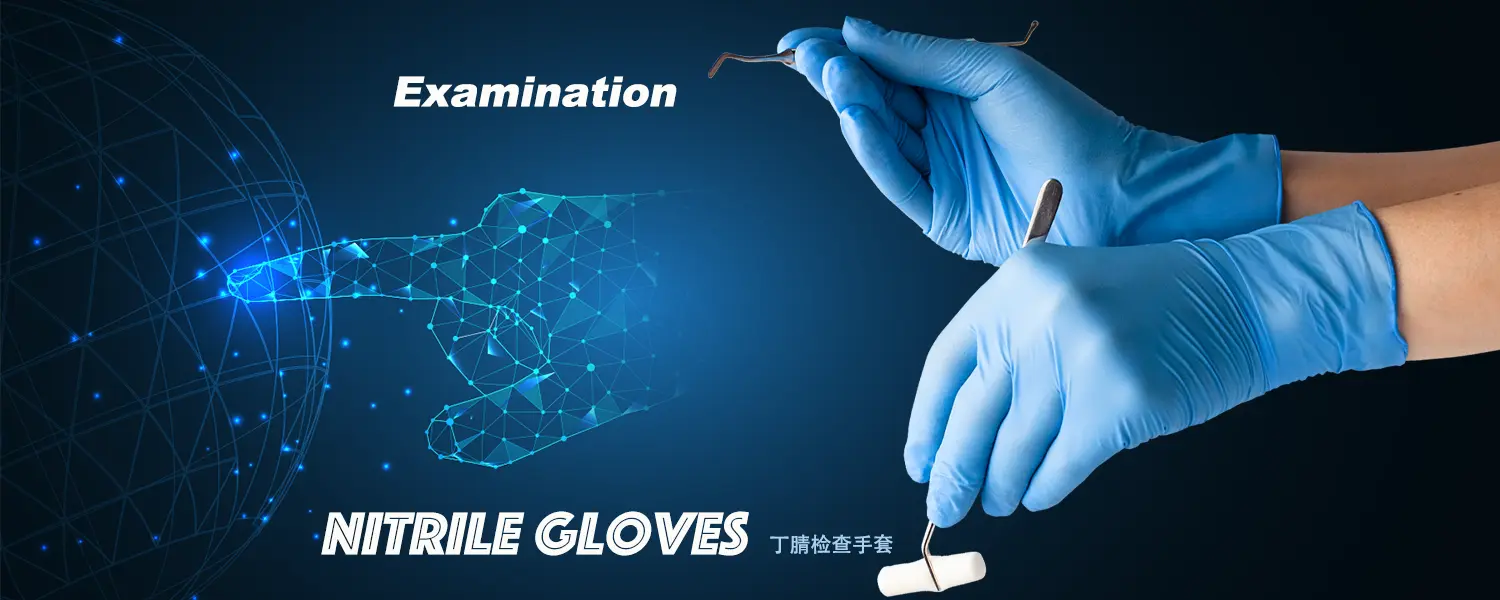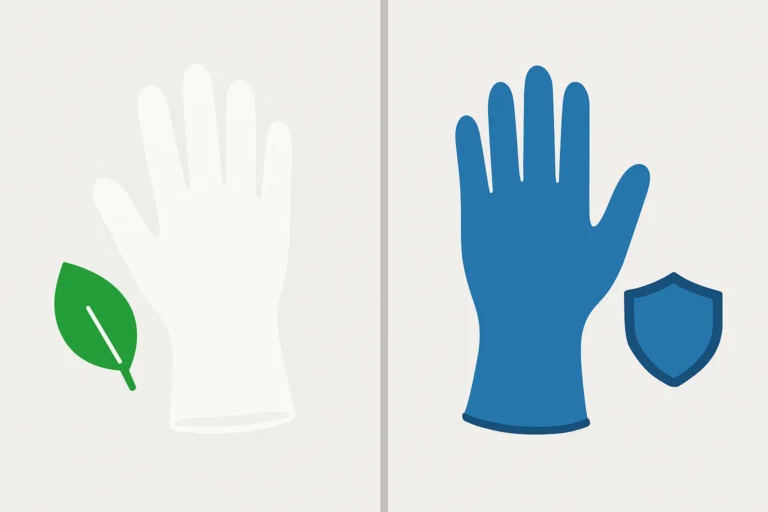Luvas de Nitrila de Grau Médico: Guia para Seleção e Segurança
Introdução:
Bem-vindo ao mundo dos luvas de nitrila de grau médico! Se já se perguntou o que as diferencia das outras ou por que se tornaram a escolha preferida na saúde, manipulação de alimentos e várias outras indústrias, você está no lugar certo.
As luvas de nitrila têm visto um aumento na popularidade, especialmente em ambientes médicos, onde segurança e higiene são primordiais. Mas o que são exatamente as luvas de nitrila e como se diferenciam de outros tipos de luvas, como látex e vinil? Mais importante ainda, como você pode ter certeza de que está escolhendo as luvas certas para suas necessidades?
Neste guia abrangente, exploraremos tudo o que você precisa saber sobre luvas de nitrila de grau médico. Desde comparações com outros tipos de luvas até compreensão de certificações e melhores práticas de uso, estamos cobrindo todos os aspectos. Seja você um profissional na área médica, um entusiasta trabalhando com produtos químicos ou simplesmente curioso sobre essas luvas versáteis, este guia foi feito para você.
Então, pegue uma xícara, acalme-se e vamos mergulhar no fascinante mundo das luvas de nitrila!

Seção 1: Comparação com Outros Tipos de Luvas
Quando se trata de escolher as luvas certas para suas necessidades, as opções podem ser um pouco abaladoras. Você provavelmente já se deparou com termos como látex, vinil e nitrila, mas o que eles realmente significam? Vamos simplificar e comparar esses três tipos comuns de luvas:
Luvas de Nitrila:
- O que são: As luvas de nitrila são feitas de borracha sintética, livre de proteínas naturais de látex.
- Vantagens: Oferecem excelente resistência a produtos químicos e perfurações. Ideais para aqueles com alergias ao látex.
- Desvantagens: Slightly mais caras e podem ser menos flexíveis.
Luvas de Látex:
- O que são: As luvas de látex são feitas de látex natural de borracha, um recurso renovável.
- Vantagens: Conhecidas por sua flexibilidade e conforto. Oferecem um ajuste apertado.
- Desvantagens: Não são adequadas para aqueles com alergias ao látex. Menos resistentes a produtos químicos.
Luvas de Vinil:
- O que são: As luvas de vinil são feitas de PVC (polivinil clorido) e plastificantes.
- Vantagens: Geralmente mais baratas e adequadas para tarefas de curto prazo.
- Desvantagens: Menos duráveis e não ideais para manipulação de produtos químicos ou objetos pontiagudos.
Então, Qual Escolher?
- Para Uso Médico: As luvas de nitrila são frequentemente preferidas devido à sua durabilidade e propriedades hiperalgênicas.
- Para Manipulação de Alimentos: Tanto as luvas de nitrila quanto as de vinil podem ser adequadas, dependendo da tarefa.
- Para Uso Geral: Considere a tarefa em questão e quaisquer alergias potenciais. As luvas de nitrila oferecem proteção geral, enquanto o látex proporciona conforto e o vinil é uma opção econômica.
Em Conclusão:
Escolher as luvas certas não precisa ser complicado. Pense no que você as usará, e considere fatores como conforto, durabilidade e alergias. Seja você um profissional de saúde, um cozinheiro caseiro ou alguém que gosta de projetos faça-você-mesmo, entender as diferenças entre luvas de nitrila, látex e vinil ajudará você a tomar uma decisão informada.
Lembre-se, não há uma resposta única para todos, mas esperamos que esta comparação tenha iluminado o tema e facilitado sua escolha.
Seção 2: Entendendo a Aprovação da FDA para Luvas de Grau Médico
Quando se trata de luvas de grau médico, você pode ter ouvido o termo “aprovado pela FDA”. Mas o que isso realmente significa e por que é tão importante? Vamos desvendar este mistério juntos!
O que é Aprovação da FDA?
A FDA, ou Administração de Alimentos e Medicamentos (FDA), é uma agência governamental responsável por garantir a segurança e eficácia de vários produtos, incluindo dispositivos médicos como luvas. Quando uma luva é aprovada pela FDA, significa que ela atende a padrões e regulamentações específicos da agência.
Por que é Importante a Aprovação da FDA?
Imagine que está comprando um assento de segurança para um bebê. Você gostaria de ter certeza de que é seguro e atende a todos os padrões necessários, certo? O mesmo se aplica às luvas de grau médico. A aprovação da FDA garante que as luvas são:
- Seguras para Uso: Foram testadas para qualidade e não se rasgam ou perfuram facilmente.
- Eficazes: Oferecem a proteção que afirmam, seja contra produtos químicos, bactérias ou vírus.
- Confiáveis: Você pode confiar que elas vão funcionar conforme esperado, a cada vez.
Como Verificar a Aprovação da FDA?
Se você estiver prestes a comprar luvas de nitrila de grau médico, aqui está como verificar a aprovação da FDA:
- Verifique as Etiquetas: Verifique a embalagem por um logotipo da FDA ou declaração de conformidade.
- Pergunte ao Fornecedor: Não hesite em perguntar ao fornecedor ou fabricante por documentos de certificação.
- Verifique Online: Alguns fabricantes oferecem acesso online a documentos de certificação e testes.
Em Conclusão:
A aprovação da FDA não é apenas um termo bonito ou uma manobra de marketing. É um selo de qualidade e garantia de que as luvas que você está usando estão à altura da tarefa, especialmente em ambientes críticos como a saúde.
Então, na próxima vez que você estiver comprando luvas de grau médico, tire um momento para verificar a aprovação da FDA. É um passo pequeno que pode fazer uma grande diferença na garantia da segurança e da tranquilidade.
Lembre-se, seja você um profissional de saúde ou alguém que simplesmente quer a melhor proteção, entender a aprovação da FDA é essencial para tomar uma decisão informada. Boa caça de luvas!
Seção 3: Uso de Luvas de Nitrila na Manipulação de Produtos Químicos
Manipular produtos químicos pode parecer algo apenas feito por cientistas em blusões brancas, mas é mais comum do que se imagina! Seja você limpando o banheiro com detergente forte ou trabalhando em um projeto faça-você-mesmo envolvendo tintas e solventes, você está lidando com produtos químicos.
Então, como as luvas de nitrila podem salvar a sua vida? Vamos descobrir!
Por que Escolher Luvas de Nitrila para Manipulação de Produtos Químicos?
As luvas de nitrila são como os heróis do mundo das luvas quando se trata de lidar com produtos químicos. Aqui está o porquê:
- Fortes e Resistentes: Diferente de outros tipos de luvas, as luvas de nitrila são conhecidas por sua resistência a uma ampla gama de produtos químicos.
- Sem Preocupações com Alergias: Como são livres de látex, você não precisa se preocupar com alergias ao látex.
- Boa Aderência: Muitos luvas de nitrilo vêm com superfícies texturizadas, proporcionando uma melhor aderência em recipientes escorregadios.
Dicas para o Uso de Luvas de Nitrilo com Químicos:
- Escolha a Espessura Apropriada: Químicos mais pesados podem requerer luvas mais grossas. Verifique a embalagem para obter orientações.
- Use e Retire com Cuidado: Evite respingos ao usar e remover as luvas com atenção.
- Descarte de forma Apropriada: Após o uso, descarte as luvas em um lixo apropriado, especialmente se tiverem entrado em contato com químicos perigosos.
- Verifique por Danos: Antes de usar, verifique sempre por qualquer rasgo ou perfuração.
Uma Palavra sobre Rótulos de ‘Resistentes a Químicos’:
Você pode encontrar luvas rotuladas como ‘resistentes a químicos’. Isso significa que foram testadas especificamente contra certos químicos. É uma boa ideia verificar o rótulo para ver se as luvas são adequadas para os químicos que você vai manipular.
Em Conclusão:
O uso de luvas de nitrilo em manipulação de químicos não é apenas para profissionais em laboratórios. Trata-se de manter-se seguro, seja no trabalho ou realizando tarefas domésticas.
Lembre-se, não todas as luvas são iguais, e quando se trata de químicos, as luvas de nitrilo são frequentemente os melhores companheiros que você pode ter. Assim, na próxima vez que você pegar aquele spray de limpeza ou diluente de tinta, certifique-se de que tem suas confiáveis luvas de nitrilo à mão!
Fique seguro e feliz na manipulação!
Seção 4: Dicas para Usar e Remover Luvas de Nitrilo de forma Apropriada
Usar e remover luvas pode parecer uma tarefa fácil, mas quando se trata de luvas de nitrilo, especialmente em cenários médicos ou de manipulação de químicos, há um pouco mais a considerar. Vamos explorar algumas dicas úteis para garantir que você esteja aproveitando ao máximo suas luvas!
Usando Luvas de Nitrilo: Guia Passo a Passo
- Verifique por Danos: Antes de usá-las, dê uma rápida inspeção nas luvas para qualquer rasgo ou buraco.
- Encontre o Tamanho Apropriado: Luvas que estão muito apertadas ou soltas podem causar problemas. Certifique-se de que você tem o tamanho certo.
- Mãos Secas: Certifique-se de que suas mãos estão secas, pois mãos molhadas podem tornar a colocação de luvas um pouco difícil.
- Coloque-as: Gently insira sua mão na luva, tomando cuidado para não puxar muito.
- Ajuste conforme necessário: Uma vez usadas, ajuste as luvas para se encaixar confortavelmente ao redor dos dedos e pulsos.
Removendo Luvas de Nitrilo: Faça-o da forma correta
- Pincele e Mantenha: Pincele o lado externo de uma luva perto do pulsos e remova-a gentilmente para baixo.
- Gire para Dentro: Enquanto remove, a luva deve virar-se para dentro. Mantenha-a na sua mão coberta.
- Insira um Dedo: Com a sua mão desprotegida, insira um dedo sob o pulsos da luva restante.
- Remova: Remova a segunda luva com cuidado, virando-a para dentro e envolvendo a primeira luva.
- Descarte de forma Apropriada: Coloque as luvas em um lixo apropriado, especialmente se tiverem entrado em contato com químicos ou materiais médicos.
Em Conclusão:
Usar e remover luvas de nitrilo não é ciência da space, mas um pouco de cuidado vai longe para garantir segurança e higiene. Seja você um herói da saúde, um entusiasta do faça você mesmo ou alguém que gosta de manter tudo impecável em casa, essas dicas podem tornar sua experiência com luvas uma brisa.
Lembre-se, não é apenas sobre usar as luvas; é sobre usá-las da forma correta. Assim, na próxima vez que você usar um par de luvas de nitrilo, você saberá que está fazendo isso como um profissional!
Feliz uso de luvas e fique seguro!






